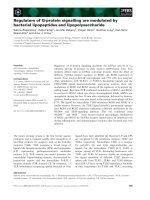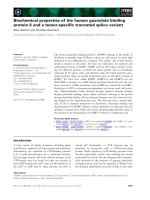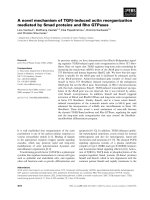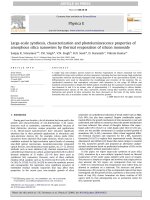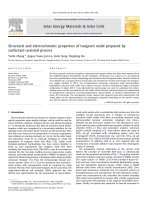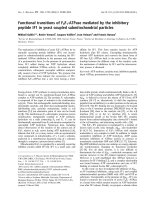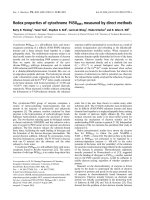Anti tumor properties of lactobacilli are mediated by immuno modulation and direct cytotoxicity
Bạn đang xem bản rút gọn của tài liệu. Xem và tải ngay bản đầy đủ của tài liệu tại đây (1.96 MB, 200 trang )
ANTI-TUMOR PROPERTIES OF LACTOBACILLI
ARE MEDIATED BY IMMUNO-MODULATION AND
DIRECT CYTOTOXICITY
CAI SHIRONG
NATIONAL UNIVERSITY OF SINGAPORE
2010
ANTI-TUMOR PROPERTIES OF LACTOBACILLI
ARE MEDIATED BY IMMUNO-MODULATION AND
DIRECT CYTOTOXICITY
CAI SHIRONG
B.Sc (Hons), NUS
A THESIS SUBMITTED
FOR THE DEGREE OF
DOCTOR OF PHILOSOPHY
DEPARTMENT OF SURGERY
NATIONAL UNIVERSITY OF SINGAPORE
2010
i
Acknowledgements
I would like to express my heartfelt gratitude to everyone who had helped me and made
my pursuit for the PhD degree a pleasant and fulfilling experience.
To my supervisor, Dr Ratha Mahendran, for her invaluable advice and guidance, without
of which my PhD project would not have been so fruitful. To my co-supervisors, Prof
Bay Boon Huat and A/Prof Lee Yuan Kun, for taking time off their busy schedules to sit
through my updates and giving me advice and encouragement.
To my fellow colleagues, Shih Wee, Mathu, Juwita and Rachel, thank you for all the
support and patience you have shown me through the years. Your encouragement and
help made my PhD journey a much sweeter one. Many thanks to Eng Shi, Kishore, Ms
Chan Yee Gek and Mr Low Chin Seng, for all the technical help and advice given to me.
To my CRCEC friends, Evelyn, Elaine, Delicia, Sally, Gaik Chin, Eric and Hafizah,
thank you for your lovely company and for lending me a listening ear or a helping hand
whenever I need it.
I would like to thank my parents and brothers for their love, faith and support. Thank you
for always believing in me and encouraging me to go a little further, dream a little bigger.
Last but not least, my significant other, Terry, thank you for being my pillar of support
and for being there with me always, through the high and lows of my PhD journey.
ii
Table of Contents Page
Acknowledgements……………………………………………………………………. i
Table of Contents …………………………………………………………………… ii
Summary………………………………………………………………………………. x
List of Tables.…………………………………………………………………………. xii
List of Figures…………………………………………………………………………. xiv
List of Abbreviations………………………………………………………………… xvi
List of publications and conference papers…………………………………………… xix
Chapter 1 Introduction ……………………………………………………………… 1
1.1 Cancer…………………………………………………………………………… 2
1.1.1 Cancer and its prevalence……………………………………………… 2
1.1.2 Causes of cancer … ………………………………………………… 2
1.2 Cancer treatments.……………………………………………………………… 3
1.2.1 Surgery………………………………………………………………… 3
1.2.2 Chemotherapy…………………………………………………………. 3
1.2.3 Radiation………………………………………………………………. 4
1.2.4 Immunotherapy……………………………………………………… 4
1.2.5 Future of cancer therapy………………………………………………. 5
1.3 Role of immune system in anti-tumor response……………………………… 5
1.4 Cell death pathways induced by chemotherapuetic drugs used in
cancer therapy…………………………………………………………………… 7
iii
1.5 Bacteria in cancer therapy………………………………………………………. 8
1.5.1 Bacteria as immunotherapeutic agents……………………………………… 8
1.5.2 Bacteria as a delivery vehicle……………………………………………… 9
1.5.3 Bacterial cytotoxic agents…………………………………………………… 9
1.5.4 Limitations………………………………………………………………… 10
1.6 Lactobacilli………………………………………………………………………. 10
1.6.1 Health benefits of Lactobacilli…………………………………………… 11
1.6.2 Anti-tumor effects of lactobacilli………………………………………… 14
1.6.2.1 Immunologically mediated anti-tumor effect……………………… 14
1.6.2.2 Non-immunologically mediated anti-tumor effect………………… 16
1.6.3 Lactobacilli immuno-modulatory potential.……………………………… 17
1.6.3.1 Lactobacilli modulate host immune response in vitro and in vivo…. 17
1.6.3.2 Receptor mediated interaction between lactobacilli and innate
immune cells………………………………………………………. 20
1.6.3.2.1 Toll like receptors……………………………………… 20
1.6.3.2.2 Mannose receptors………………………………………. 21
1.6.3.2.3 NOD like receptors……………………………………… 21
1.6.3.3 Bridging innate and adaptive immunity………………………… 22
1.6.3.3.1 Macrophages……………………………………………. 22
1.6.3.3.2 Dendritic cells………………………………………… 22
1.6.3.3.3 Neutrophils…………………………………………… 23
1.6.3.3.4 Dendritic cell and neutrophil interaction……………… 23
1.7 Scope of study…………………………………………………………………. 25
iv
Chaper 2 Materials and Methods………………………………………………… 27
2.1 Bacteria Preparation………………………………………………………… 28
2.1.1 Live Lactobacilli………………………………………………………… 28
2.1.2 Lyophilized Lactobacilli………………………………………………… 29
2.1.3 Heat Killed LGG…………………………………………………………. 29
2.2 Ex vivo study of Lactobacilli interaction with immune cells……………… 30
2.2.1 Animals…………………………………………………………………… 30
2.2.2 Immune cells isolation……………………………………………………. 30
2.2.2.1 Isolation of bone marrow derived neutrophils and dendritic cells 30
2.2.2.2 Isolation of T-cells……………………………………………… 31
2.2.2.3 Splenocytes isolation…………………………………………… 33
2.2.3 Co-culture of immune cells with Lactobacilli
…………………………… 33
2.2.3.1 Co-culture of neutrophils or DCs with LGG …………………… 33
2.2.3.2 Study of neutrophil-neutrophil interaction……………………… 34
2.2.3.3 DC neutrophil co-culture…………………………………………. 35
2.2.3.4 DC or DC-neutrophil co-culture with T cells…………………… 35
2.2.3.5 Stimulation of splenocytes with live and lyophilized Lactobacilli 36
2.2.4 Interaction between immune cells and Lactobacilli……………………… 36
2.2.4.1 Uptake of Lactobacilli into immune cells………………………… 36
2.2.4.2 Blocking phagocytosis……………………………………………. 36
2.2.4.3 Cytokine and PGE2 ELISA………………………………………. 37
2.2.4.4 Blocking TLR2 and 9…………………………………………… 38
2.2.4.5 Flow cytometric analysis of surface markers and receptors on
DCs and neutrophils……………………………………………… 39
v
2.2.4.6 Blocking IL10 and COX2 in DC neutrophil co-culture…………. 40
2.2.4.7 Effect of LGG on neutrophil viability…………………………… 40
2.2.4.7.1 Annexin V-PI staining of neutrophils………………… 40
2.3 Cytotoxic effect of Lactobacilli on cancer cells……………………………… 41
2.3.1 Cancer and normal cell lines……………………………………………… 41
2.3.2 Direct co-culture of MGH with lactobacilli………………………………. 41
2.3.3 Production of cytotoxic molecule from LGG…………………………… 42
2.3.3.1 Cytotoxic molecule production in the culture supernatant……… 42
2.3.3.2 Extraction of LGG cytoplasmic fraction………………………… 42
2.3.3.3 Optimization of cytotoxic molecule production …………………. 42
2.3.3.4 Growth curve of LGG in media…………………………………… 43
2.3.3.5 Measurement of pH, lactate and glucose………………………… 43
2.3.4 Characterization of cytoxic molecule…………………………………… 44
2.3.4.1 Stability of cytotoxic molecule……………………………………. 44
2.3.4.2 Molecular size of cytotoxic molecule…………………………… 44
2.3.4.3 Nature of cytotoxic molecule……………………………………… 44
2.3.4.3.1 Proteinase K and trypsin digestion……………………… 44
2.3.4.3.2 Chloroform extraction…………………………………… 45
2.3.5 Effect of cytotoxic molecule on human cells……………………………… 45
2.3.5.1 Cell viability assays……………………………………………… 45
2.3.5.1.1 MTS and Multitox-fluor assay………………………… 45
2.3.5.1.2 Cell Count ………………………………………………. 46
2.3.5.2 Mechanism of cell death………………………………………… 46
vi
2.3.5.2.1 Caspase 3/7 activity……………………………………… 46
2.3.5.2.2 Lactate dehydrogenase (LDH) test………………………. 46
2.3.5.2.3 Cell cycle analysis……………………………………… 47
2.3.5.3 Effect of cytotoxic molecule on a panel of cancer and normal cells 47
2.3.5.4 Visualization of cell-lines…………………………………………. 48
2.3.5.4.1 Light and fluorescence microscopy…………………… 48
2.3.5.4.2 Electron microscopy…………………………………… 48
2.3.5.5 Uptake of cytotoxic molecule…………………………………… 49
2.3.5.6 Cellular Pathways activated by the cytotoxic molecule………… 50
2.3.5.6.1 Total RNA extraction and cDNA conversion…………… 50
2.3.5.6.2 LDA…………………………………………………… 51
2.3.5.6.3 Real-time PCR………………………………………… 53
2.3.5.6.4 RT-PCR…………………………………………………. 53
2.3.5.6.5 Protein isolation from MGH cells………………………. 55
2.3.5.6.6 Western Blot of ACVR1C, pSMAD2 and SMAD.…… 55
2.3.6 Purification of cytotoxic molecule……………………………………… 56
2.3.6.1 High Performance Liquid Chromatography (HPLC)…………… 56
2.3.6.2 Gas chromatography TOF mass spectropmetry (GC-TOFMS)… 57
2.4 Statistical Analysis…………………………………………………………… 58
Chapter 3 Results Part I: Immuno-stimulatory effect of lactobacilli………… 59
3.1 Interaction of Neutrophils and LGG………………………………………… 60
3.1.1 Internalization of LGG induces cytokine production in neutrophils…… 60
vii
3.1.2 Role of toll-like receptor 2 in LGG stimulation of neutrophils…………… 63
3.1.3 LGG induced cell death in neutrophils……………………………………. 64
3.1.4 Effect of LGG on surface marker expression in neutrophils……………… 66
3.1.5 Neutrophil-neutrophil interaction after exposure to LGG………………… 67
3.2 Effect of dose and exposure time of LGG on DC maturation and
DC-neutrophils cross talk…………………………………………………… 69
3.2.1 Maturation of dendritic cells is dependent on bacteria dose,
exposure time and presentation by neutrophils…………………………… 70
3.2.2 Dose and duration of LGG exposure skews cytokine profile in DC and
DC neutrophil co-culture…………………………………………………. 73
3.2.3 Effect of high LGG dose on IL12 production is dependent on
IL10 levels but not Prostaglandin E2 (PGE2) levels…………………… 76
3.2.4 Downstream T-cell activation is dependent on the bacteria dose
exposed to the DCs………………………………………………………. 78
3.3 Differential Immuno-stimulatory potential of live and lyophilized
Lactobacillus species ……………………………………………………… 79
3.3.1 Different strains of lactobacilli induce different levels of TNF,
IL10 and IL12p40 ………………………………………………………. 79
3.3.2 Lyophilized lactobacilli induced more TNF, IL10 and IL12p40 ……… 81
3.3.3 Contact is required for lactobacilli to stimulate spleen cells to
produce cytokines……………………………………………………… 83
3.3.4 Lactobacilli stimulate splenocytes through TLR2 but not TLR9……… 84
3.3.5 Phagocytosis plays a role in cytokine induction by L.bulgaricus……… 85
Summary I……………………………………………………………………. 87
Chapter 3 Results Part II: Direct cytotoxic effect of lactobacilli on cancer cells 89
3.4 Optimization of lactobacilli mediated direct cytotoxic effects on
cancer cells…………………………………………………………………… 90
viii
3.4.1 Effect of media pH on cytotoxic effect…………………………………… 90
3.4.2 Comparison of the cytotoxic effect of different lactobacillus strains ……. 91
3.4.3 LGG produced cytotoxic molecules are released into the culture supernatant 92
3.4.4 Other conditions that affect cytotoxicity of LGG………………………… 93
3.4.5 Glucose and amberlite enhances production of cytotoxic molecules by LGG 94
3.4.6 Culture media conditions at the end of 24 hours of incubation…………… 97
3.5 Characterizations of the cytotoxic molecule(s)………………………………… 98
3.5.1 Basic characterization of the cytotoxic molecule…………………………… 98
3.5.2 Purification of cytotoxic molecule from LGG supernatant…………………. 100
3.5.3 Possible identity of cytotoxic molecules, determined by GC-TOFMS ……. 101
3.6 Uptake of cytotoxic molecule into MGH cells…………………………………. 104
3.7 Cytotoxic and anti-proliferative effect of LGG supernatant and LCT……… 105
3.7.1 Cell cycle analysis with propidium iodide…………………………………. 106
3.7.2 LCT induced apoptosis in MGH but not LGG supernatant……………… 106
3.7.3 Morphologies of MGH cells treated with LGG supernatant and LCT…… 109
3.8 LGG supernatant preferentially targets cancer cells and not normal cells… 112
3.9 Effect of LGG supernatant and LCT on gene expression in MGH cells…… 114
3.9.1 Confirmation of gene expression with real-time PCR ……………………. 114
3.9.2 Confirmation of gene expressions with RT-PCR…………………………. 116
3.10 Gene and protein expressions of ACVR1C…………………………………. 118
Summary II…………………………………………………………………… 120
Chapter 4 Discussion………………………………………………………………. 122
4.1 Phagocytosis and TLR2 are important mediators of the interaction
of lactobacilli with immune cells ………………………………………………. 123
ix
4.2 Downstream effects of lactobacilli interaction with immune cells…………… 126
4.3 Differential immunostimulatory potential of live and lyophilized
lactobacillus strains……………………………………………………………… 130
4.4 Dose and exposure time dependant variation in the modulation
of the activity of neutrophils, dendritic cells and T cells by LGG………………. 131
4.5 Production of cytotoxic molecule and its characteristics……………………… 135
4.6 Cell death mechanism and specificity for cancer cells………………………… 137
4.7 Pathways triggered by LCT and LGG supernatant………………………………. 141
4.8 ACVR1C signaling and apoptosis……………………………………………… 142
4.9 Conclusions………………………………………………………………………. 145
4.10 Limitations ………………………………………………………………………. 147
4.11 Future directions………………………………………………………………… 148
Chaper 5 References………………………………………………………………… 150
x
Summary
Lactobacillus species are part of the commensal microflora in animals and humans and
are commonly used as probiotics. There are reports in the literature that lactobacilli have
very promising anti-tumor effects both in animals as well as in clinical studies.
Administration of Lactobacillus reduced tumor growth, prevented recurrence of cancer
and improved survival rates. The anti-tumor effect of lactobacilli can be attributed to their
ability to modulate host immune system as well as direct cytotoxic effects on tumor cells.
Immune cells like neutrophils have been reported to be recruited to the tumor site
upon intravesical instillation of lactobacilli. Our studies on lactobacilli interaction with
immune cells show that both phagocytosis of Lactobacillus and toll-like receptor 2
(TLR2) signaling were found to be important processes in lactobacilli stimulation of
immune cells. Neutrophils, which are rapidly recruited to the tumor site after
administration of lactobacilli, engulf the bacteria and communicate with other naïve
neutrophils by the release of soluble factors and/or direct contact. We also showed that
Lactobacillus rhamosus GG (LGG) stimulated neutrophils were able to induce activation
of dendritic cells (DC) and induce subsequent Th1 polarization in T cells. The dose and
exposure duration of LGG used to stimulate DCs directly or indirectly via neutrophils
determines the extent of DC maturation. Greater DC maturation and subsequent greater
Th1 polarization of T cells was achieved with a low LGG dose (10:1) compared to high
dose (100:1).
The immuno-stimulatory potential of several lactobacillus strains were studied
and L. bulgaricus was found to induce the greatest amount of TNF, IL12 and IL10
xi
production in splenocytes. The process of lyophilization also significantly increased the
immunogenicity of lactobacilli.
Direct cytotoxic effects on the human bladder cancer cell line, MGH was
exhibited by all the lactobacilli strains (LGG, L.bulgaricus, L.casei strain Shirota and
L.acidophilus) tested, with LGG showing the strongest effect. The cytotoxic molecule
was characterized as less than 1kD in molecular size, non-labile, resistant to digestion by
proteases and is most likely to be a sugar as determined by gas chromatography time-of-
flight mass spectrometry (GC-TOFMS). The purified fraction containing this molecule
was found to induce apoptosis in cancer cells while the crude preparation induced G2/M
arrest. The cytotoxic molecule preferentially kills cancer cells but not normal cells.
Several genes were found to be upregulated after treatment with LGG supernatant or the
purified fraction of LGG supernatant containing the cytotoxic molecule. Expression of
activin receptor 1C (ACVR1C), one of the genes upregulated, correlates well with
responsiveness to the cytotoxic molecule.
Our data revealed that duration and dose of lactobacilli exposure to DCs and
neutrophils affect Th1 polarization of T cells. The different strains of lactobacilli showed
differential immunostimulatory potential and their immunogenicity can be enhanced by
lyophilization. All the above variables can alter the efficacy of lactobacilli as an
immunotherapeutic agent. The cytotoxic molecule produced by LGG can also be a
potential chemotherapeutic agent. With better understanding of the mechanism of action
of lactobacilli, they can be optimally used as safer and more effective cancer therapies in
the future.
xii
List of Tables Page
1.1 Characteristics of cell death pathways…………………………………………. 8
1.2 General Health Benefits of lactobacilli………………………………………… 12
1.3 Postulated mechanisms of lactobacilli chemoprevention of cancer…………… 13
1.4 In vitro studies on lactobacilli stimulation of cytokine production in
immune cells…………………………………………………………………… 19
2.1 TaqMan® primers for real-time PCR…………………………………………. 53
2.2 Primer sequences and annealing temperatures used for RT-PCR…………… 54
3.1 Viability of LGG, 18 hours after internalization……………………………… 61
3.2 Percentage of live and dead neutrophils after LGG treatment……………… 66
3.3 MHC I and CD11b expression on LGG treated neutrophils…………………. 67
3.4 Cytokine production by LGG-stimulated and naïve neutrophils…………… 69
3.5 Surface markers expression on DC after 2 hours of LGG exposure………… 71
3.6 Surface markers expression on DC after 18 hours of LGG exposure………… 71
3.7 Surface markers expression on DC co-cultured with LGG
stimulated neutrophils…………………………………………………………. 72
3.8 Comparison of surface marker expression between direct stimulation
of DC with LGG and indirect stimulation with LGG treated neutrophils…… 73
3.9 Cytokine production by splenocytes stimulated with live and lyophilized
lactobacilli at 48 hours…………………………………………………………. 82
3.10 LGG cytoplasmic fraction is not cytotoxic…………………………………… 93
3.11 Conditions that influence cytotoxicity of LGG on MGH cells……………… 94
3.12 Culture conditions after 24 hours of incubation……………………………… 97
3.13 Basic characterizations of cytotoxic molecule in LGG supernatant…………. 99
xiii
List of Tables Page
3.14 Identities of differential peaks in purified fraction of LGG supernatant…… 104
3.15 Cell cycle analysis of MGH with propidium iodide…………………………. 106
3.16 List of genes up regulated in LCT treated MGH…………………………… 114
xiv
List of Figures Page
1.1 Role of innate and adaptive immunity in anti-tumor response………………… 7
1.2 Cross talk between neutrophils and DCs………………………………………. 24
2.1 Growth curves of L. bulgaricus, LcS and LGG……………………………… 29
2.2 Purity of immune cells…………………………………………………………. 32
2.3 Experimental setup for study of neutrophil-neutrophil interaction…………… 35
2.4 PI staining profile of untreated cancer cells……………………………………. 47
2.5 Efficacy of endocytotic inhibitors on blocking uptake of their respective
ligands by MGH……………………………………………………………… 50
3.1 Internalization of LGG is important for stimulation of cytokine
production in neutrophils……………………………………………………… 62
3.2 Role of TLR2 in LGG and neutrophil interaction……………………………… 64
3.3 Viability of neutrophils after exposure to LGG………………………………… 65
3.4 Dose dependent cytokine productions………………………………………… 75
3.5 IL10, not PGE2, is responsible for the low IL12p70 production with
high dose of LGG……………………………………………………………… 77
3.6 T cell activation is dependent on LGG dose……………………………………. 78
3.7 Differential ability of live lactobacilli strains to induce cytokine production
in splenocytes……………………………………………………………………. 80
3.8. Cytokine production in splenocytes with and without contact separation
from lactobacilli…………………………………………………………………. 83
3.9 The effect of TLR2 inhibition on cytokine induction by live lactobacilli……… 85
3.10. Effect of blocking phagocytosis on cytokine production by splenocytes
stimulated with L. bulgaricus………………………………………………… 86
3.11 Effect of pH on LGG induced cytotoxicity on MGH cells…………………… 91
3.12 Comparison of lactobacilli cytotoxic effect…………………………………… 92
xv
List of Figures Page
3.13 LGG culture supernatant has cytotoxic effects……………………………… 93
3.14 Growth curves of LGG in media and the enhancement of cytotoxicity
with increased glucose concentration and addition of amberlite……………… 96
3.15 Cytotoxicity of lactate on MGH cells…………………………………………. 97
3.16 Purification of LGG supernatant using HPLC………………………………… 101
3.17 Comparison of GC-TOFMS chromatograms of LGG supernatant and
control media…………………………………………………………………… 103
3.18 Effect of chemical inhibition of endocytotic pathways on cytotoxic effect of
LGG supernatant on MGH…………………………………………………… 105
3.19 Caspase 3/7 and LDH assays on MGH cells treated with LGG supernatant or
LCT for 24 hours………………………………………………………………. 107
3.20 Confocal microscope photos of Hoechst 33258 stained MGH cells after
24 hours treatment with LGG supernatant or LCT……………………………. 108
3.21 Morphologies of MGH cells after LGG supernatant and LCT treatment for
24 hours………………………………………………………………………… 110
3.22 Morphologies of MGH cells after LCT treatment at 12
th
, 16
th
and 20th hours… 111
3.23 Differential cytotoxic effects on carcinoma and normal cells by
LGG supernatant……………………………………………………………… 113
3.24 Gene expressions of ACVR1C, RET and EPHB6 in treated MGH
confirmed by real time PCR……………………………………………………. 115
3.25 Gene expression confirmed by RT-PCR……………………………………… 117
3.26 Gene and protein expressions of ACVR1C…………………………………… 119
4.1 Apoptotic pathways triggered by ACVR1C activation………………………… 145
xvi
List of Abbreviations (In alphabetical order)
APC
Allophycocyanin
APCs
Antigen Presenting Cells
ATP
Adenosine-5'-triphosphate
BCG
Bacillus Calmette-Guérin
BSA
Bovine serum albumin
CAM
Cell adhesion molecule
CCL
CC Chemokine ligand
CD
Cluster of differentiation
CXCL
Chemokine (C-X-C motif) ligand
cDNA
Complementary Deoxyribonucleic acids
CFU
Colony Forming Unit
C
T
Threshold cycle
DC
Dendritic Cell
DNA
Deoxyribonucleic acids
dNTP
Deoxynucleotides
ELISA
Enzyme linked immunosorbent assay
FACS
Fluorescence activated cell sorting
FBS
Fetal bovine serum
FITC
Fluorescein isothiocyanate
GC-TOF/MS
Gas chromatography-time of flight mass spectrometry
GM-CSF
Granulocyte macrophage colony stimulating factor
HMGB
High mobility group box protein
HPLC
High performance liquid chromatography
HRP
Horseradish peroxidase
IFN
Interferon gamma
Ig
Immunoglobulin
IL
Interleukin
kD
Kilo Dalton
LcS
Lactobacillus casei strain Shirota
xvii
LCT
Lacto cyto-toxin (purified fraction of LGG supernatant)
LDA
Low Density Array
LDH
Lactate dehydrogenase
LGG
Lactobacillus rhamnosus GG
Lyo
Lyophilized
MBC
Methyl-beta-cyclodextrin
MHC
Major histocompatibility complex
MRS
deMan Rogosa Sharpe
NK
Natural Killer
NOD
Nucleotide-binding oligomerization domain
OD
Optical Density
ODN
Oligonucleotide
PBMC
Peripheral blood mononuclear cells
PBS
Phosphate buffered saline
PCR
Polymerase Chain Reaction
PE
Phycoerythrin
PG
Penicillin G
PGE2
Prostagladin E2
PGN
Peptidoglycan
PI
Propidium Iodide
PS
Pencillin G - Streptomycin
RBC
Red blood cell
RNA
Ribonucleic acid
RQ
Relative Quantification
RT
Room temperature
RT-PCR
Reverse Transcriptase-Polymerase Chain Reaction
SEM
Standard error of the mean
SFM
Serum Free Media
TEM
Transmission Electron Microscope
TGF
Transforming growth factor beta
Th
T helper
xviii
TLR
Toll Like receptor
TMR
Tetra-methyl-rhodamine
TNF
Tumor necrosis factor alpha
TNFR
Tumor necrosis factor receptor
TRAIL
TNF-Related Apoptosis Inducing Ligand
xix
List of Publications and Conference papers
Journal Publications
1. Cai, S., Bay, B.H., Lee, Y.K., Lu, J., Mahendran, R. (2010) Live and lyophilized
Lactobacillus species elicit differential immunomodulatory effects on immune
cells. FEMS Microbiol Lett 302, 189-96.
2. Seow, S.W., Cai, S., Rahmat, J.N., Bay, B.H., Lee, Y.K., Chan, Y.H., Mahendran,
R. (2010) Lactobacillus rhamnosus GG induces tumor regression in mice bearing
orthotopic bladder tumors. Cancer Sci 101, 751-8.
3. Pasikanti, K.K., Norasmara, J., Cai, S., Mahendran, R., Esuvaranathan, K., Ho,
P.C., Chan, E.C. (2010) Metabolic footprinting of tumorigenic and
nontumorigenic uroepithelial cells using two-dimensional gas chromatography
time-of-flight mass spectrometry. Anal Bioanal Chem. Aug 5 Epub ahead of print
Conference Papers
Poster presentation
1. Cai, S., Rahmat, J.N., Kandasamy, M., Tham, S.M. Lee, Y.K, Bay, B.H.,
Mahendran, R. Dose dependant variation in the modulation of the activity of
neutrophils, dendritic cells and T cells by Lactobacillus rhamnosus GG.
International Anatomical Sciences and Cell Biology Conference. Singapore. May
2010.
2. Cai, S., Lee, Y.K, Bay, B.H., Mahendran, R. Interaction of neutrophils with
Lactobacillus rhamnosus GG. 5
th
Asian Conference on Lactic Acid Bacteria.
Singapore. Jul 2009.
3. Cai, S., Lee, Y.K, Bay, B.H., Mahendran, R. Lactobacillus species- cytotoxic
activity to cancer cells. National Healthcare Group Annual Scientific Congress.
Singapore. Nov 2007.
4. Cai, S., Lee, Y.K, Bay, B.H., Mahendran, R. Lactobacilli inhibits proliferation
and induce cytotoxicity in bladder cancer cell lines American Association for
Cancer Research (AACR) Centennial Conference on Translational Cancer
Medicine. Singapore. Nov 2007.
5. Cai, S., Lee, Y.K, Bay, B.H., Mahendran, R. Live and lyophilized Lactobacillus
species elicit differential immunostimulatory potential. 4
th
Asian Conference on
Lactic Acid Bacteria. Shanghai, China. Oct 2007.
1
Chapter 1
Introduction
2
1.1 Cancer
1.1.1 Cancer and its prevalence
Cancer is a disease where cells undergo uncontrolled division and eventually invade and
destroy adjacent tissues, resulting in metastasis to distant sites of the body via the lymph
or blood. It is the world‟s second biggest killer after cardiovascular disease, killing 7.4
million people in 2004, according to statistics from World Health Organisation (WHO).
By 2015, this number is expected to rise to 9 million and increase further to 12 million in
2030 [1].
1.1.2 Causes of cancer
Cancer arises from a single cell that is transformed from a normal cell to a tumor cell due
to genetic abnormalities. These abnormalities may occur as a result of exposure to
physical carcinogens (ultra-violet and ionizing radiation), chemical carcinogens [tobacco,
asbestos and aflatoxin (a food contaminant)] or infection/inflammation [induced by
hepatitis B virus and human papillomavirus (HPV), schistosomes]. All the above may
cause mutations in the genomic DNA. The most detrimental mutations are those that
occur in either the cancer promoting oncogenes or in tumor-suppressor genes. Activation
of the former in cancer cells promotes hyperactive cell division and inhibits apoptosis
while inactivation of the latter results in a loss of normal cell cycle progression or
accurate DNA replication.
3
1.2 Cancer treatments
1.2.1 Surgery
Surgical procedures are used to remove the tumor mass and the tissue surrounding the
tumor and draining lymph nodes. This treatment is more suitable for solid tumors which
are detected early, before metastasis sets in. However, due to the risk of microscopic
remnants of cancerous cells, post-surgery adjuvant therapies such as chemotherapy,
radiotherapy or immunotherapy are used to augment cure rates.
1.2.2 Chemotherapy
Chemotherapy involves the use of anti-neoplastic drugs to treat cancer and it typically
targets rapidly dividing cells, which is a characteristic of most cancer cells. However as a
result of this, chemotherapy will also kill normal healthy cells that undergo frequent cell
division like cells in the bone marrow, hair follicles and gut mucosa. This leads to the
commonly seen side effects of hair loss, myelosuppression (decrease in production of
blood cells) and inflammation of the digestive tract mucosal lining.
Aside from the side effects, chemotherapy also has its limitations namely: i) in
large tumors the cells in the center may have stopped dividing making them insensitive to
chemotherapeutic drugs; ii) the drugs may not be able to reach the centre of large tumors
and iii) cancer cells may develop chemoresistance by over expressing multidrug efflux
pumps like p-glycoprotein [2] that pump out the chemotherapeutic drugs.
4
1.2.3 Radiation
Like surgery, radiotherapy is a local treatment, affecting only the treated area.
Radiotherapy involves the use of high-energy rays to kill cancer cells and stop them from
growing and dividing. The major side effects of radiation therapy are limited to the
treated area such as skin irritation, redness or swelling. The other common side effects
are fatigue, nausea and loss of appetite.
1.2.4 Immunotherapy
Immunotherapy is a form of treatment that stimulates the body's own immune system to
fight infection and disease. In the late 1800‟s, William B. Coley was amongst the first to
draw an association between bacterial infection and tumor regression. He eventually went
on to develop a vaccine consisting of 2 killed bacteria – Streptococcus pyogenes and
Serratia marcescens to stimulate an infection and managed to achieve complete,
prolonged regression of several cancers like lymphomas, melanomas and myelomas [3].
With increasing knowledge of tumor immunology and the immune system, other forms
of cancer immunotherapy using monoclonal antibodies, cytokines (e.g. interferon,
interleukin-2), biological agents [e.g. Mycobacterium bovis, Bacillus Calmette-Guérin
(BCG)] and cancer vaccines have been developed.
Monoclonal antibodies used for cancer immunotherapy are raised against tumor
antigens. Once bound, the foreign cells are destroyed either by antibody dependent cell
mediated cytotoxicity (ADCC) or complement dependent cytotoxicity (CDC) [4]. One
example of a monoclonal antibody used for cancer therapy is Rituximab, which targets
